28 Creative Nature Faces Crafts for Kids to Explore the Outdoors
There’s something truly magical about watching a child’s face light up when they create art from natural treasures! I completely understand what you mean. In our blended family, nature face crafts have become one of our most beloved activities.
Nature crafts have this wonderful way of combining creativity with outdoor exploration. My kids get so excited about collecting materials – they’ll spend hours hunting for the “perfect” leaf or the “most special” rock. It’s much better than being glued to screens all afternoon!
I’ve noticed that these activities really do help with focus too. My youngest daughter, who can sometimes bounce from activity to activity, will sit contentedly arranging and rearranging her nature face elements until everything is just right. The natural materials seem to have a calming effect while still sparking imagination.
One of our favorite family traditions is creating seasonal nature faces. In spring, we use fresh flower petals and tender green leaves. Summer brings vibrant materials like sunflower centers and colorful stones. Fall is obviously amazing with all those gorgeous leaves! And even winter has its unique treasures – pinecones, evergreen sprigs, and interesting twigs make for wonderfully expressive creations.
I’ve compiled our family’s favorite nature face craft ideas below, organized by season and material type. These projects have brought us countless hours of joy and connection. Plus, they’re super affordable – Mother Nature provides all the supplies for free!
I’ll create 10 original descriptions for nature faces crafts with specific details. Each will be about 5 sentences long and varied from one another.

Get Your Free Cozy Mom Toolkit!
Struggling to find time for fun crafts, healthy snacks, and a calm home? The Cozy Mom Toolkit is here to help! Inside, you’ll get quick toddler-friendly snack ideas, easy low-mess crafts, and a simple daily routine to bring more peace and joy into your home. Download your free copy now and start creating cozy moments today!
Seasonal Tree Face Guardians

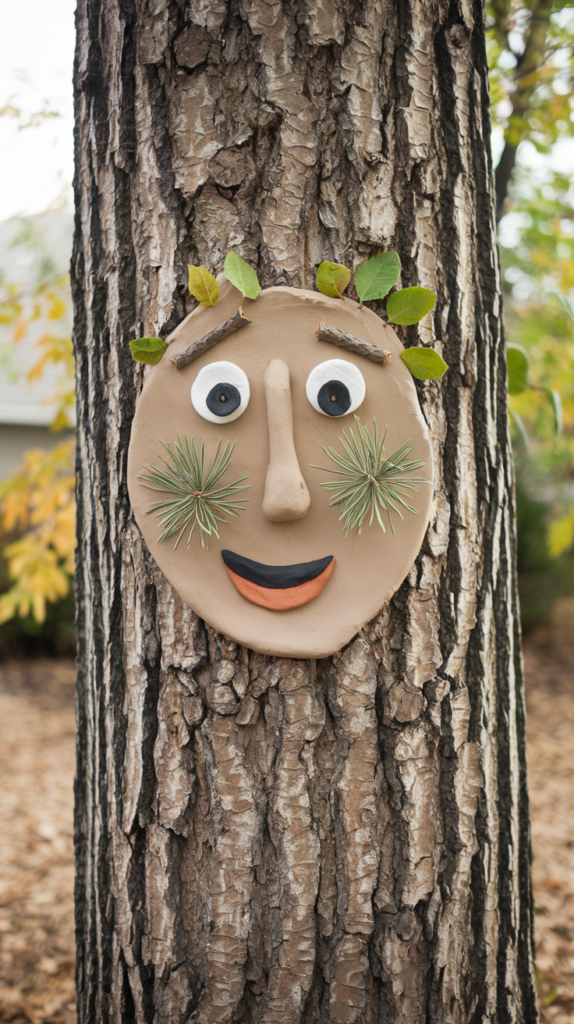
Transform a living tree in your yard into a friendly guardian by creating a removable face using clay pressed with natural textures. Press leaves, pine needles, and small twigs into air-dry clay to create expressive eyes, noses, and smiling mouths that can be temporarily attached to tree trunks. Take photos of your tree guardians in different seasons to create a year-long documentation of how the surrounding nature changes. Remember to remove the clay pieces afterward to protect the tree, making this an eco-friendly, leave-no-trace craft. This activity teaches children about respectful interaction with living nature while developing their three-dimensional art skills.
Floating Leaf Face Boats
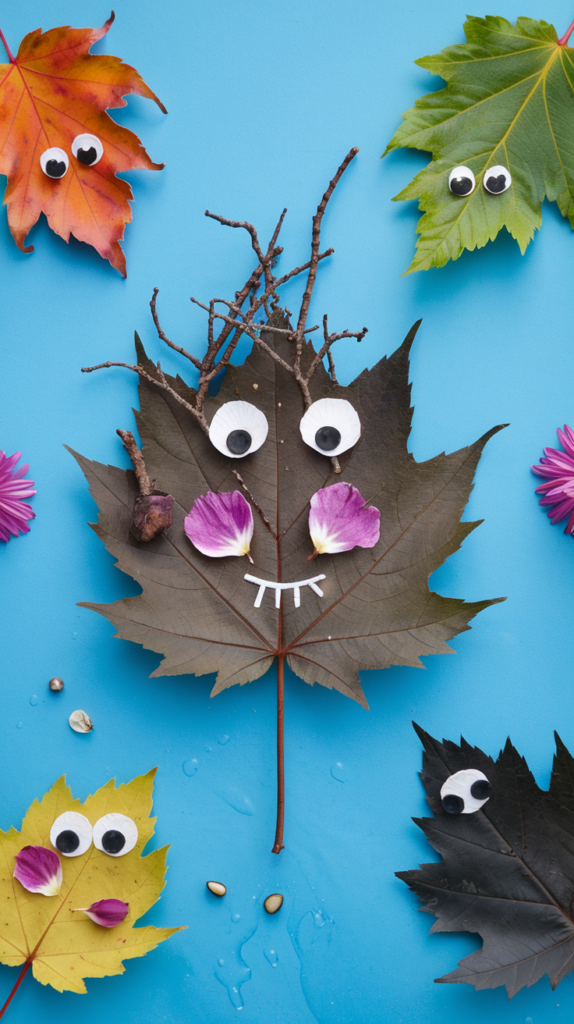
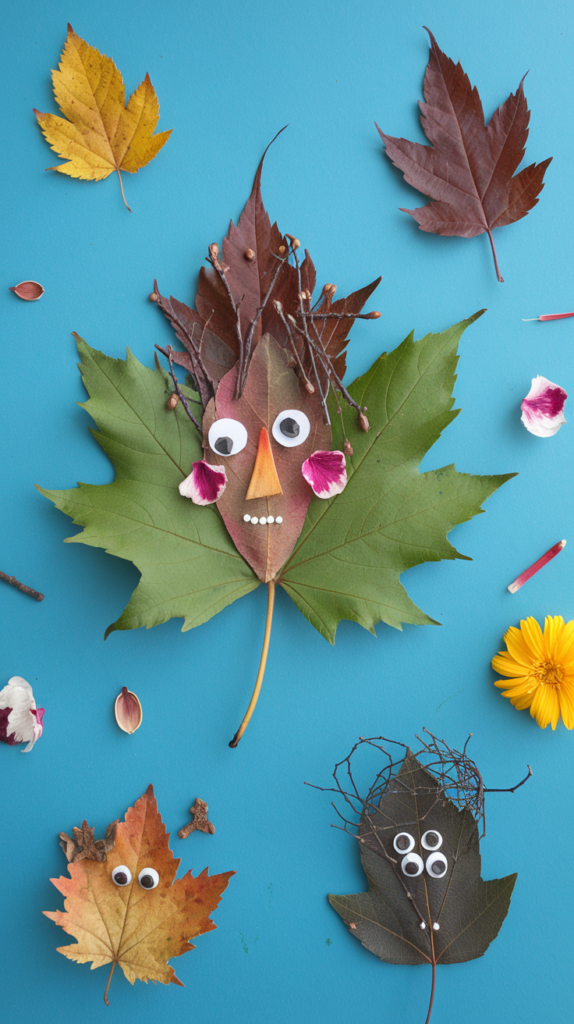
Collect large sturdy leaves like maple or oak to serve as the “boat” base for creating miniature face characters that can actually float. Use smaller leaves for features, flower petals for cheeks, seeds for eyes, and twigs for hair, attaching them with tiny dots of natural beeswax or mud. Test your leaf face boats in a creek, puddle, or bathtub to see which designs float best and which materials are most water-resistant. Document which natural materials work best for watercraft, creating a perfect blend of science and art exploration. This activity sparks discussions about buoyancy while encouraging children to think critically about material properties.
Shadow Nature Faces
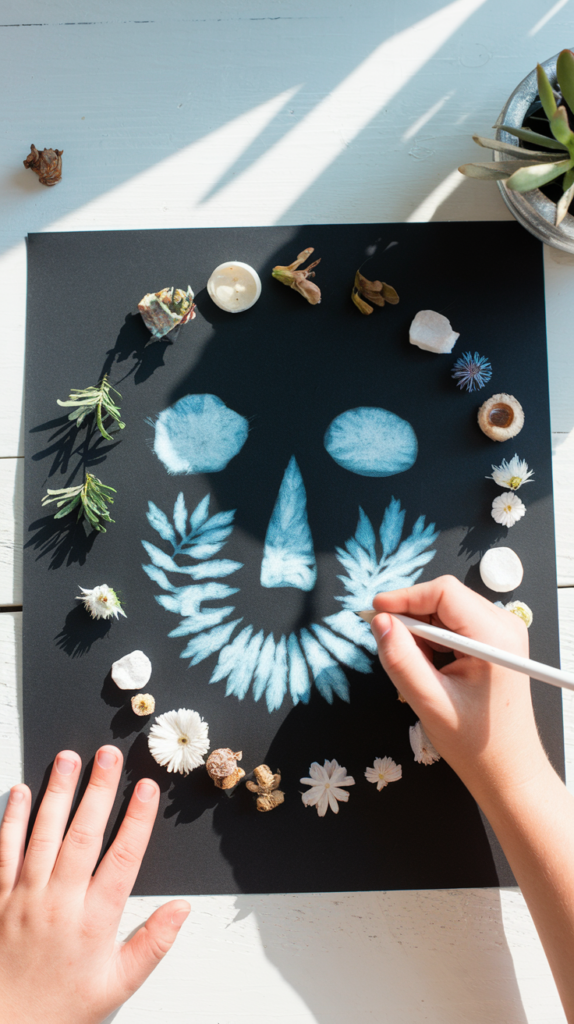
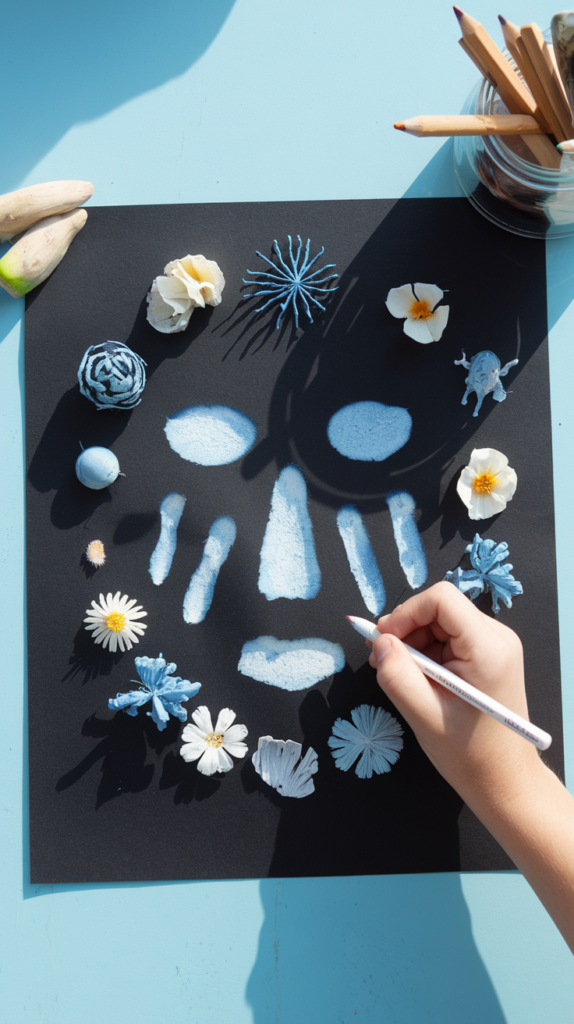

Gather a variety of natural materials and arrange them on black construction paper placed in direct sunlight, creating a face design that will leave a shadow print. After several hours in strong sunlight, carefully remove the natural items to reveal ghostly blue-white silhouettes where the sun couldn’t reach. Enhance the prints with white colored pencils or chalk to emphasize features and add details that weren’t captured in the sun printing process. Frame these ethereal nature face prints or compile them into a “shadow face” storybook with characters your children invent. This craft introduces children to cyanotype principles and the science of light in an accessible, creative way.
Ephemeral Beach Face Portraits

On your next beach trip, challenge children to create giant face portraits in the sand using only found natural materials like seaweed hair, shell eyes, and driftwood smiles. Photograph these temporary masterpieces from above (standing on a bench or chair) to capture the full effect before the tide reclaims the art. Create a time-lapse if possible showing how waves gradually transform and eventually erase the face, teaching children about impermanence in both art and nature. This activity helps children practice working on a larger scale while embracing the temporary nature of environmental art.
Sticky Window Nature Faces

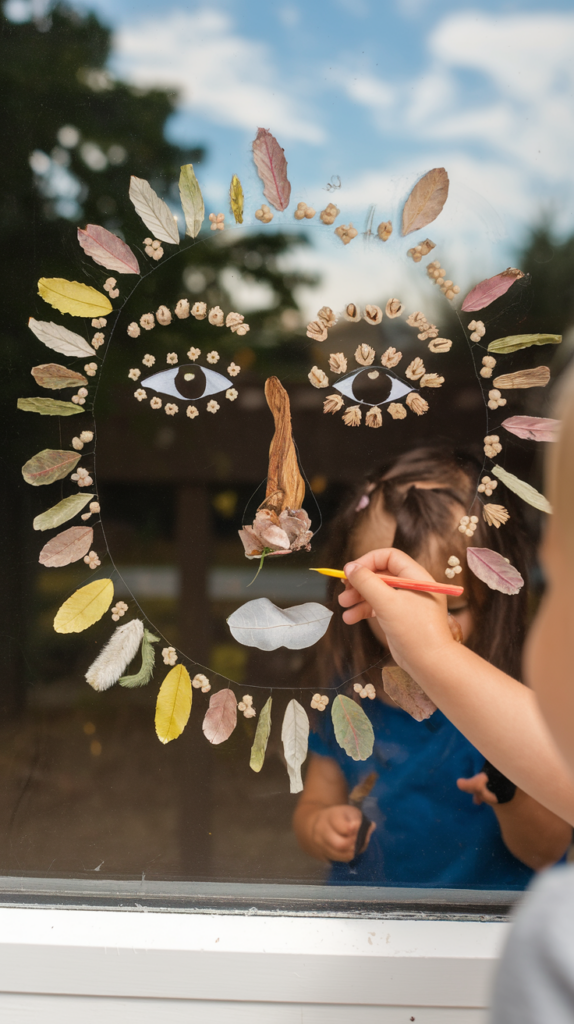
Cut contact paper into circle shapes, remove the backing, and place the sticky side out on windows, then venture outdoors to collect materials for creating whimsical face designs that can be viewed from both inside and outside your home. The translucent quality of many natural materials like thin leaves, flower petals, and seed pods creates a beautiful stained-glass effect when light shines through. Keep these window faces up for several weeks to observe how the materials change as they dry, teaching children about preservation and decomposition. Add to the learning experience by having children draw the same face composition on paper both when freshly made and after weeks of transformation.
Mud Face Clay Masks

After a good rain, collect some mud from your yard and mix it with a bit of grass seed to create a natural modeling clay perfect for making three-dimensional face masks on cardboard backing. Press in pebbles, twigs, leaves, and other natural items to create features, then allow the mud mask to dry completely in the sun. Water the dried mud mask lightly each day and watch as the embedded grass seeds begin to sprout “hair” over the course of a week or two. This living sculpture teaches children about germination while creating a constantly evolving piece of art that bridges the gap between craft and gardening.
Nature Face Mandalas

Begin by finding a flat area outdoors and place a circular item like a hula hoop to create a defined workspace, then collect natural materials sorted by color to create a face mandala with radial symmetry. Start from the center (perhaps a sunflower or pinecone for the nose) and work outward in concentric circles, using progressively larger materials as you expand. Take overhead photos at various stages of completion to show the evolution of your face mandala design. This meditative activity teaches mathematical concepts like symmetry and pattern-making while encouraging mindfulness and appreciation for color variations in nature.
Frozen Nature Face Suncatchers


During winter months, fill shallow containers like pie tins or frisbees with water and arrange natural items to form face designs, then place outdoors to freeze overnight (or in your freezer if temperatures aren’t cold enough). Once frozen solid, remove the ice faces from the containers and hang them with string in trees or from porches where sunlight can shine through them. Document how these crystalline sculptures slowly melt and transform, eventually returning the natural materials back to the earth. This seasonal craft combines science concepts about states of matter with artistic expression and appreciation for winter’s unique creative opportunities.
Nature Face Crowns

Measure your child’s head circumference and create a base ring using flexible vines, slender branches, or floral wire wrapped with thin strips of bark or long grasses. Create a face on the front of the crown using collected natural materials—perhaps acorn cap eyes, a pinecone nose, and berry lips—secured with twine or hidden twist ties. Extend the design around the sides and back with additional natural elements like feathers, interesting seed pods, or cascading leaves to create a wearable piece of nature art. These crowns make perfect props for outdoor dramatic play, nature-themed birthday parties, or magical forest adventures.
Storytelling Stone Faces


Collect smooth, flat stones of various sizes and use natural pigments made from crushed berries, clay, charcoal, or turmeric mixed with a drop of water to paint expressive faces representing different emotions and characters. Create an entire cast of stone face characters with distinctive personalities, perhaps including family members, friends, or imaginary beings from your child’s favorite stories. Use these stone face characters to tell stories on a natural “stage” created from a hollow log, arrangement of sticks, or sand pit theater. This activity combines art with literacy skills as children develop narratives around their stone face characters.
Fairy Stump Face Houses

Find a fallen log or tree stump and transform it into an enchanted fairy face house using natural materials to craft both facial features and tiny furniture. Carve gentle indentations for eyes and a mouth, then embellish with moss eyebrows, pebble pupils, and mushroom ears that double as small tables. Create miniature ladders from crossed twigs, beds from curved bark, and chairs from acorns with leaf backs. Add a “welcome mat” made from woven grasses and tiny glowing lanterns from hollow seed pods with fireflies temporarily housed inside (always release them by nightfall). This interactive craft becomes an ongoing project as children add new elements and create stories about the fairy face who lives in their natural dwelling.
Sound-Making Nature Faces

Design musical face instruments using hollow gourds, coconut shells, or large seed pods as the base, decorating them with natural materials to create expressive features. Fill the hollow vessels partially with dried beans, small pebbles, or seeds to create different rattling sounds when shaken. Attach reed whistles made from hollow plant stems for the nose, and stretchy bark strips across openings for twanging string sounds that form the mouth. Incorporate pine cone scales as movable parts that click together when manipulated for the eyebrows or hair. These multisensory face instruments encourage children to explore sound properties while creating functional, interactive art from nature’s materials.
Pressed Flower Face Journals
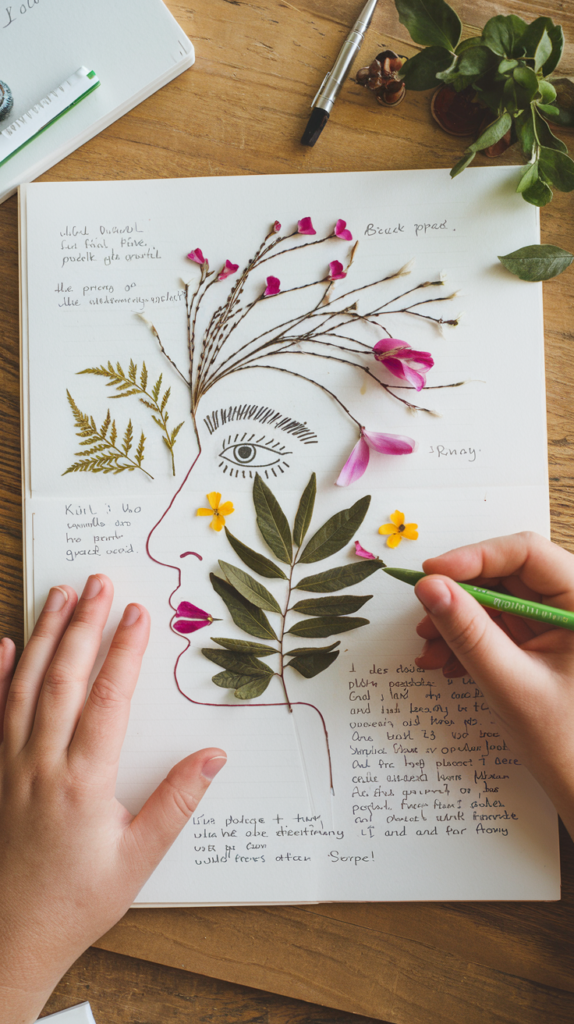

Collect delicate flowers, leaves, and grasses to press between heavy books for several weeks until completely flat and dry. Using acid-free paper, create a face in profile using the pressed botanicals—perhaps rose petals for lips, fern fronds for eyelashes, and delicate Queen Anne’s lace for hair. Combine these pressed nature faces with handwritten observations about where each plant was found, creating a scientific journal that merges botany with artistic expression. This keepsake project teaches patience and preservation techniques while developing a deeper connection to local plant species.
Vine and Twig Face Sculptures

Soak flexible vines like grapevine, willow, or honeysuckle in water overnight to make them pliable, then bend and weave them into three-dimensional face frameworks. Use natural twine to secure intersections and create a sturdy but flexible structure that serves as the foundation for adding features. Weave smaller materials through the framework—seed pods for eyes, pinecones for noses, and woven grass for lips—creating dimension and texture. These sculptural faces can hang on walls or from tree branches where they catch the breeze and create subtle movement, gradually changing as they weather over time.
Nature Face Light Catchers


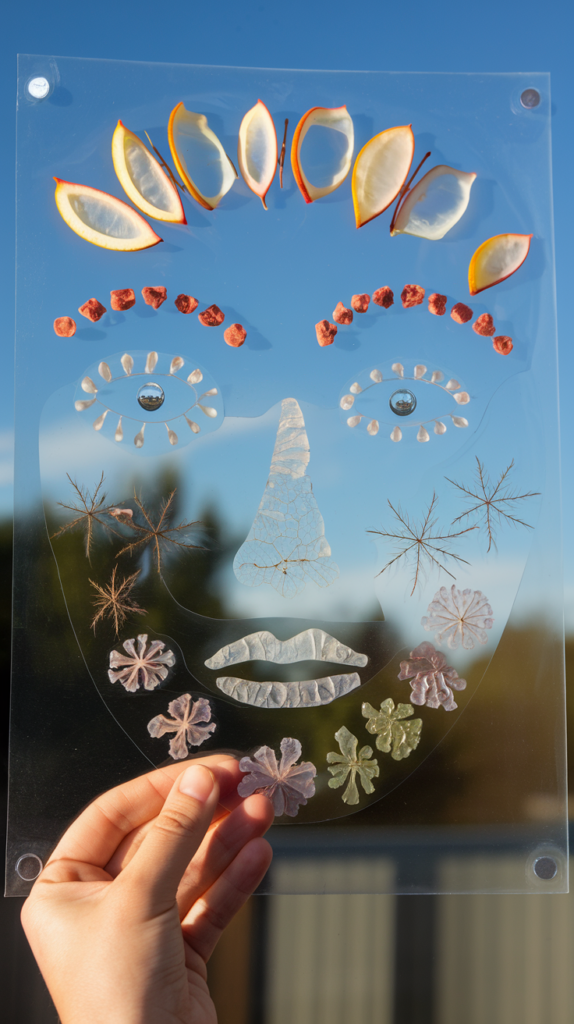
Collect transparent and translucent natural materials like thinly sliced fruit peels, skeletal leaves from last season, gossamer seed heads, and paper-thin mica flakes found near streams. Arrange these luminous materials between two sheets of clear contact paper cut in a face shape, carefully positioning the translucent elements to create features that glow when backlit. Hang these ethereal faces in windows where morning or afternoon light will shine through them, casting colored shadows and illuminating the intricate patterns within each natural material. These light catchers provide a perfect opportunity to discuss how light interacts with different substances and the concept of transparency.
Bird Feeder Faces

Create biodegradable bird feeder faces using a base of stale bagels, large slices of oranges, or thick slabs of dense bread as the foundation. Spread a mixture of peanut butter and gelatin as “glue” across the surface, then arrange seeds, nuts, and dried berries to form facial features—sunflower seed eyebrows, cranberry eyes, and corn kernel smiles. Hang these feeding faces in trees where birds can gradually dismantle them, observing which parts disappear first and which bird species prefer certain “features.” This functional craft teaches children about local bird species and their feeding preferences while creating temporary art that benefits wildlife.
Indigenous Material Faces
Research traditional art forms from indigenous cultures in your region and learn which natural materials were historically used for creative expression. With appropriate respect for cultural traditions, guide children to create faces using only materials native to your specific bioregion—perhaps clay sourced from a local creek bed, pigments from natural minerals, and fibers from indigenous plants. Document the sourcing process and the significance of each material, creating an educational connection between art, culture, and place. This thoughtful craft helps children understand the deep historical relationship between people and their local environment.
Macro-Photography Faces

Challenge older children to find “faces” that already exist in nature—the patterns in tree bark that resemble eyes, the curve of a leaf that suggests a smile, or the arrangement of seeds that form features. Using a smartphone with a macro lens attachment or a magnifying glass, photograph these natural face formations up close, revealing intricate details invisible to the naked eye. Compile these discovered faces into a digital or printed field guide of “Nature’s Hidden Faces,” complete with location information and scientific identification of the plants where these faces were found. This observational craft develops pattern recognition skills and encourages children to notice minute details in the natural world.
Pollinator-Friendly Face Gardens


Design a face-shaped garden bed with different sections for facial features, planting each area with specific pollinator-friendly native plants. Use purple coneflowers for expressive eyes, bright orange butterfly weed for a prominent nose, and red bee balm for full lips, connecting these features with paths of creeping thyme or chamomile. Install a rain gauge in one eye and a thermometer in the other to track weather conditions affecting your living face garden. This long-term project teaches principles of garden design, plant science, and ecological relationships while creating a beautiful living artwork that changes with the seasons.
Sunrise Shadow Face Installations


Wake up early and head to an east-facing natural area with a collection of sticks, stones, and other vertical natural materials. Position these elements strategically on the ground so that when the sun rises, they cast shadows that align to create a giant face on a flat surface. Document the transformation as the sun moves higher and the shadows shift, eventually dissolving the face entirely by mid-morning. This ephemeral installation teaches concepts of astronomy, shadow formation, and impermanence while encouraging children to consider how positioning and timing affect artistic outcomes.
Fungal Spore Print Faces

Collect mature mushrooms (with adult supervision to ensure they’re non-toxic varieties) and carefully remove their caps to create spore print faces. Place the mushroom caps gill-side down on paper in face arrangements—using different sized caps for eyes, nose, and mouth—then cover with a bowl overnight. As the mushrooms release their spores, magical face impressions appear in dusty patterns of white, brown, or purple depending on the mushroom species. Spray these delicate spore print faces with fixative to preserve them, then use them as the basis for creative stories about forest spirits or earth guardians. This craft introduces children to mycology while creating truly unique artwork that cannot be precisely duplicated.
Bioluminescent Night Faces

During summer months when fireflies are active, create special evening nature faces using materials that glow or reflect light. Position small mirrors or quartz crystals for twinkling eyes, phosphorescent fungi (like ghost fungus) for a glowing nose, and arrange firefly observation areas with nectar-rich flowers to attract these insects as moving, blinking lights around your face design. Photograph these magical nighttime faces using long exposure settings to capture the movement of light. This nocturnal craft opens up discussions about bioluminescence, nocturnal creatures, and how different ecosystems change after sunset.
Erosion Face Landscapes

At the beach or in a sandbox, create a three-dimensional face landscape with varied elevations—raised eyebrow ridges, a prominent nose hill, and a valley mouth. Strategically place different natural materials like pebbles, sticks, and leaves across the landscape, then use a watering can to create “rain” and observe how water creates erosion patterns across your face terrain. Document the changes through time-lapse photography as certain features wash away while others remain more resistant. This geologically-focused craft demonstrates principles of erosion, watershed formation, and the power of water to shape our environment.
Grass Seed Animation Faces

Create a sequence of face designs using grass seed sprinkled on damp soil in shallow trays, with each tray showing a slightly different expression—perhaps a face that gradually breaks into a smile across 5-7 trays. Water the trays and place them in sunlight, then watch as the green grass grows to reveal your sequential face expressions. Photograph each tray from the same angle daily, then compile the images into a stop-motion animation of a growing grass face that changes expression. This patient craft combines principles of animation with plant biology, showing children how small incremental changes create the illusion of movement.
Morning Dew Face Webs

Rise early when morning dew is heavy and bring along pre-made face templates cut from cardboard. Find intact spider webs in your yard or local park (avoiding any with spiders still present), then gently place the cardboard behind them and lightly sprinkle flour or cornstarch to highlight the intricate web patterns caught within your face shape. Photograph these ephemeral dew-caught web faces quickly before the morning sun dries them, capturing the geometric precision of nature’s own artistry. This respectful craft (which doesn’t disturb the spider’s home but merely documents it) opens discussions about arachnid engineering and mathematical patterns in nature.
Pollen Painting Faces
During peak pollen season, place dark construction paper coated with a light layer of petroleum jelly outdoors in areas protected from wind. Use stencils to create face shapes, or arrange natural materials as face features before the pollen begins to accumulate. After several hours or days depending on pollen levels, remove the materials to reveal negative space faces amid the collected yellow, green, or white pollen particles. Preserve these unusual portraits by carefully covering with a second sheet of clear contact paper. This seasonal craft raises awareness about plant reproduction cycles and can be connected to discussions about allergies and plant biology.
Creek Bed Stone Face Mosaics

Visit a creek with smooth, varied stones and create a large-scale face mosaic directly in a shallow section of the streambed. Position larger stones for the outer face shape and major features, then use increasingly smaller pebbles to add details like pupils, nostrils, and lip lines. Observe how the flowing water changes the appearance of your creation, making stones appear darker, more vibrant, and seemingly connected as water fills the spaces between them. This temporary installation explores how water affects our perception of color and texture while teaching principals of mosaic art that date back thousands of years.
Constellation Face Star Maps

Research how different cultures throughout history have mapped the night sky, then create your own family’s face constellation maps using found natural materials on dark fabric. Position white shells, quartz stones, or pale flowers as “stars,” connecting them with lines made from light-colored grasses or yarn to create face constellations unique to your family mythology. Create an accompanying star guide that names each major point and tells the story behind your face constellation, just as ancient cultures did with their celestial observations. This astronomy-based craft connects art with cultural history and celestial navigation while encouraging children to develop their own meaningful relationship with the night sky.
Nature faces crafts combine outdoor exploration, creativity, and learning in a way that captivates kids of all ages. When children gather natural materials and transform them into expressive faces, they build a meaningful connection with the environment while stretching their creative muscles.
The beauty of these projects lies in their simplicity – no need for expensive supplies or complicated instructions. Just step outside, collect nature’s treasures, and watch your child’s imagination take over! These 28 nature faces crafts can easily become a regular activity during your family’s outdoor adventures, resulting in both beautiful artwork and lasting memories.
Grab a collection bag, head outdoors with your little ones, and discover the endless creative possibilities that nature provides. Soon your kitchen table (or even better, your backyard) will transform into an ever-changing art gallery showcasing smiling faces crafted from nature’s gifts!
Get Your Free Cozy Mom Toolkit!
Struggling to find time for fun crafts, healthy snacks, and a calm home? The Cozy Mom Toolkit is here to help! Inside, you’ll get quick toddler-friendly snack ideas, easy low-mess crafts, and a simple daily routine to bring more peace and joy into your home. Download your free copy now and start creating cozy moments today!





